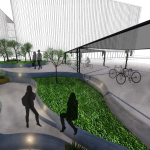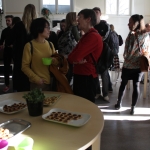The Higher Education Campus Cluster in Turku is a home for the biggest Universities and Universities of Applied Sciences in town. It forms geographically a continuous zone within a 1.5 kilometre radius of the old town to the former brownfield ring and the present flagship of the City of Turku, the coming Science & Innovation Hub in the Itäharju–Kupittaa area. All the six HEIs in Turku and the City have during the past years worked together to make the city brimming with students. The pilot is about to examine, if design and human-centered methods can help in developing the Campus Cluster as the whole, not the parts.
Inspiration for campus design thinking
What we have done since the project kick-off in December 2015? We started from a general vision to make the campus cluster more visible, more unified, and more integrated into the city structure. Thus, it has been okay to follow the design thinking process from the very beginning, and start by getting more precise insights into the space and the people in there.
We have interviewed some of the key persons, basically development and property managers from the Universities and Universities of Applied Sciences that operate in the campus cluster area.
We have also photographed the pilot area, and will repeat that constantly during the project as one of the observation methods.
One part of getting into the issue has been the Inventory report that piloting partners do with help of the Stockholm Resilience Centre. It gives a basic outlook on the area, and it will be ready by March 2016. One of the first findings has been the four sub-areas with different characteristics, and pros and contras.
It has been demanding to get accurate information on the campus cluster area, because the area is not statistically or an administrative unit, and there are many operators. Universities, Universities of Applied Sciences, the property holders, the City, etc., have also had their own strategies and realisations, and development has basically happened in parts and building-based, and not on a district level.
From inspiration into ideation in June 2016
What are we planning to do next? Ideation and testing are worthy, since you understand precisely, what you are trying to improve. We have made a general, yet flexible, plan for the whole pilot project time:
– empathize the problem by Mar. 2016, define the problem by Jun. 2016, and state the feasible Design Challenge
– ideate solutions by Dec. 2016, and prototype and test some solution(s) by Aug. 2017, and summarise the pilot by Dec. 2017.
At the moment, we need a more intensive field-study to find out, how people are using the space? And who is using the space? So, we will get in there to make field surveys, and we are interested to exploit open platforms and/or web applications in the pilot too. We should also solve, how to implement and document the pilot process so that it is valid for research purposes as well.
We organise design sprints open doors in the spring (19.4., 26.4., 12.5. & 19.5.), the aim is to convert the so far gathered data and find out few good problems that would be feasible to be solved in the project and still relevant for the HEIs and the City.
The first half of the year culminates with a Campus Design Bootcamp in the first Liveable City Forum that we organise together with the Metropolia University of Applied Sciences and the C. of Helsinki 7 – 10 Jun. 2016. In the Bootcamp 8 Jun. in Turku, the participants are challenged to create a solution into our Design Challenge just in 8 hrs. There will be 7 Jun. also a partner meeting, and a walk-tour in the campus cluster area in Turku.
Some findings to carry on
One of the first highlights has been that we have identified three different themes that seem to be jointly valid and interesting for all the HEIs on the campus cluster area:
Concepts and strategies for smart campus transformation, growth and shrinkage easily dominate discussions, because of rationalisation and intensification of premises, and savings that organisations have needed to go through. To keep and renovate an old and often legacy-bearing building, or to move or to build a new one with better possibilities to adapt to new pedagogical and worklife needs? There are also some recent show-cases for joint spaces for different HEIs on the area, like the ICT-City, the Agora-Natura, and the coming D-medisiina and the Geohus.
New dynamics of campus services has come into question in possibly future joint implementation between different HEIs, like the student services, including libraries and international student services, student and staff restaurants, sport services (already ongoing), IT services and systems (for example at joint spaces in the same building), and a joint map application and signing on the area. And in general, the campus cluster area lacks here and there other every-day services like shops, kiosks, day-care, etc. that could be run by private sector. Private car parking is present all along!
Inclusive, vibrant and accessible campus communities: the main issue seems to be to find new forms for university-business cooperation, and opening the campus space for more hybrid spaces also for companies, why not also to housing. Involving campus communities like staff and students has mainly been target-specific and concerned indoors. What else could be there?
Do the space, processes, and the communities all need to be present to make a positive impact? Follow us and find out.
By Johanna Aaltonen & Tiina Anttila, University of Turku, Turku pilot of Live Baltic Campus









